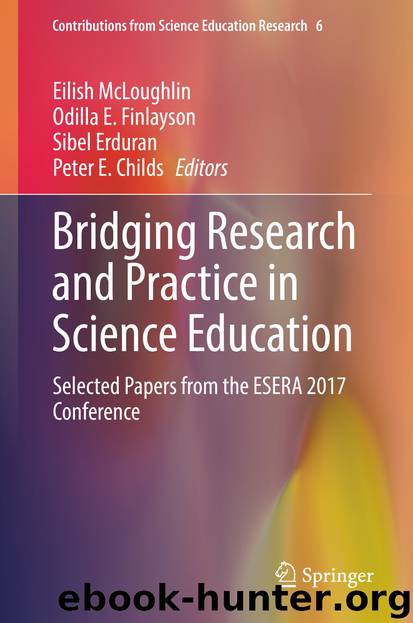Bridging Research and Practice in Science Education by Eilish McLoughlin & Odilla E. Finlayson & Sibel Erduran & Peter E. Childs

Author:Eilish McLoughlin & Odilla E. Finlayson & Sibel Erduran & Peter E. Childs
Language: eng
Format: epub
ISBN: 9783030172190
Publisher: Springer International Publishing
Mainly because students have not often had sufficient experiences with many aspects of RiNA projects, the schema in the lower right of Fig. 1 was developed to provide them with relatively teacher-led ‘apprenticeship’ lessons and activities to help them develop expertise, confidence and motivation for eventually self-directing such projects. Starting with student reflections on their existing conceptions, attitudes, etc., this constructivism-informed schema then encourages teachers to teach students some often difficult-to-discover facts, ideologies, etc. associated with science and technology before asking them to practice some small-scale RiNA projects (receiving help, when requested). Depending on numerous factors, including students’ ages and stages of development, resource availability, etc., students may require more than one set of apprenticeship lessons and activities, often providing them with increasingly more complex ASK (e.g. about actor-network theory) that they may use in RiNA projects.
Since the development of the STEPWISE frameworks, considerable qualitative educational action research has been conducted in primary, secondary and tertiary science education contexts to learn more about their effectiveness. Such research suggests, firstly, that STEPWISE-informed approaches can be helpful in promoting self-directed RiNA projects—several examples of which are provided in two special issues of the journal JASTE (goo.gl/N00b3s; bit.ly/2JGIgtf) and in an edited book (Bencze 2017 [goo.gl/q98JRv]) featuring teachers’ documentary reports of their relevant teaching/learning experiences. A brief summary1 of some major findings from research involving one teacher (drawing from 6 of 17 documentary chapters in the book) also is provided in the next section of this chapter. This is followed by a section featuring summaries2 of 5 of the 33 analyses chapters in the STEPWISE-edited book. Authors of these latter chapters were asked to analyse and evaluate STEPWISE frameworks and, where appropriate, discuss similar approaches in their work or suggest alternatives to them. We finish with an overall summary and conclusions section, coedited by all authors here.
Download
This site does not store any files on its server. We only index and link to content provided by other sites. Please contact the content providers to delete copyright contents if any and email us, we'll remove relevant links or contents immediately.
The Art of Coaching Workbook by Elena Aguilar(50989)
Trainspotting by Irvine Welsh(21519)
Twilight of the Idols With the Antichrist and Ecce Homo by Friedrich Nietzsche(18503)
Fangirl by Rainbow Rowell(9095)
Periodization Training for Sports by Tudor Bompa(8170)
Change Your Questions, Change Your Life by Marilee Adams(7635)
This Is How You Lose Her by Junot Diaz(6794)
Asking the Right Questions: A Guide to Critical Thinking by M. Neil Browne & Stuart M. Keeley(5635)
Grit by Angela Duckworth(5523)
Red Sparrow by Jason Matthews(5390)
Paper Towns by Green John(5089)
Room 212 by Kate Stewart(5037)
Ken Follett - World without end by Ken Follett(4645)
Housekeeping by Marilynne Robinson(4347)
The Sports Rules Book by Human Kinetics(4294)
Double Down (Diary of a Wimpy Kid Book 11) by Jeff Kinney(4207)
Papillon (English) by Henri Charrière(4195)
The Motorcycle Diaries by Ernesto Che Guevara(4012)
Exercise Technique Manual for Resistance Training by National Strength & Conditioning Association(3956)
